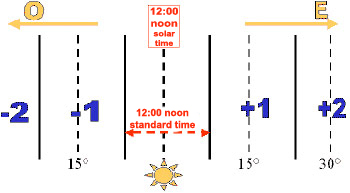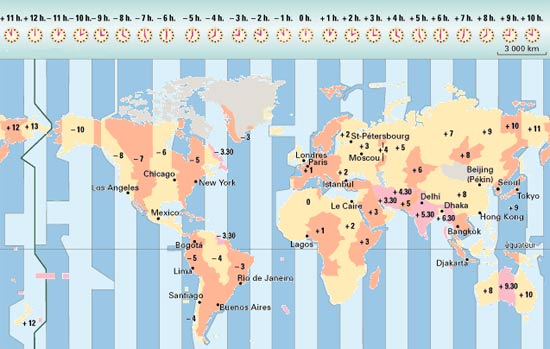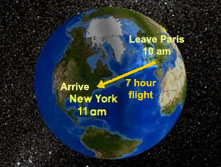|
|

The expression “jet
lag ” is sometimes mistakenly used to refer to any
discomfort experienced during a long airplane trip. Certainly,
after a 10-hour north-south flight from Germany to South
Africa, for example, passengers may feel very tired because
of sitting still for so long, breathing the dry air on the
plane, and so on. But the true
symptoms of jet lag occur only when people make
flights across multiple meridians of longitude. Someone who
makes a 5-hour flight from New York to Los Angeles will therefore
experience much more trouble over the next few days than
someone who has made that 10-hour flight from Germany to
South Africa, which are only one time zone apart. |
|
|
The alternation of day and night is the result
of the Earth’s rotation on its axis. One complete rotation
of the Earth takes 24 hours, the length of one day.
This constant rotation of the Earth upon its axis posed a problem
when efforts began to create a single time-reference system for
all people everywhere on Earth. If noon were defined as the time
when the sun reached its highest point in the sky, then noon would
occur at a given time for people at any given location, but a few
seconds later for people at another location just a few metres
farther west, and several minutes earlier for people living a few
dozen or a few hundred kilometres farther east. The only people
who lived at different locations but experienced noon at the same
time would be those who lived north or south of each other along
the exact same meridian. All of this would obviously be pretty
impractical if people were trying to created a unitary time-reference
system.
To solve this problem, time zones were
created. Time zones are a convention according to which all locations
between two meridians separated by 15 degrees of longitude use
the same time. Why 15 degrees? Simply because the circumference
of the Earth comprises a total of 360 degrees of longitude, and
360 degrees divided by the 24 hours in a day equals 15. The standard
time for any given time zone equals the local solar time at the
central meridian in that zone (the dotted vertical lines in the
diagram below).

This system was first proposed in 1876, with
the meridian that passes through the city of Greenwich, England
as the reference for the other time zones. The imaginary line where
the date changes (the International Date Line) thus runs through
the Pacific Ocean, for the most part following the 180th meridian
of longitude.

Time zones make it easier to state the arrival
time, in local time, for trips over long distances in today’s
rapid jet airliners. For instance, suppose an airplane takes off
from Paris, France at 10:00 AM local time and takes 7 hours to
make the flight to New York. In the process, however, it “flies
back”through 6 time zones, so that its passengers arrive
in New York at 11:00 AM local time, only 1 hour later than they
left Paris.

|
If they don’t go to
bed that night until late evening New York time, these passengers
will have been awake for 6 hours longer than their hosts and
so feel very sleepy long before bedtime. For the same reason,
many of these travellers will wake up in the middle of the
night, ready to start their day: their bodies’ biological
clocks will still be operating on Paris time. These people
are experiencing the disagreeable phenomenon known as jet
lag. |
The reason that we experience jet lag is that our bodies have
evolved for hundreds of thousands of years according to the
natural rhythm of the 24-hour day and have adapted to it in many
ways. In fact, this is the entire subject of the field of chronobiology.
Evolution never foresaw that in the course of scarcely a century, people would
invent airplanes and start making long-haul flights routinely. In nature, the
length of the day changes with the season, but does so imperceptibly, over several
months. When people fly from one continent to another, their day can be shortened
or lengthened by several hours all at once!
The result is the
many symptoms of jet lag, which reflect the work that the body has to do
to resynchronize
its various biological clocks in response to this sudden time change.
|
|







